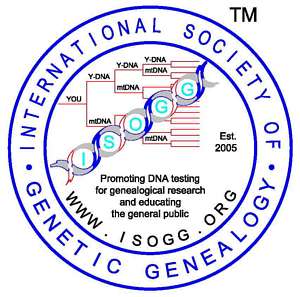Back to SNP Index
Back to Papers Cited
Back to Glossary Back to Listing Criteria
Copyright 2007, 2008 International Society of Genetic Genealogy. All Rights Reserved.

| LINKS: Main Page SNP Index Papers Cited Glossary Listing Criteria |
| CLADE/SUBCLADE SYMBOLS: Added Redefined |
| SNP SYMBOLS: Not on 2007 tree Confirmed within subclade Provisional Private |
Y
�
A M91, P97
�
BT SRY1532.1/SRY10831.1, M42, M94, M139,
M299
(This category is also referred to as YxA.)
� �
B M60, M181, P85, P90
� �
CF M168, M294, P9.1
� �
� DE
M1/YAP, M145/P205, M203, P144, P153, P165, P167, P183
� �
� �
D M174, 021355
� �
� �
E
M40/SRY4064/SRY8299, M96, P29, P150, P152, P154, P155, P156, P162, P168, P169, P170,
P171, P172, P173, P174, P175, P176
� �
� C,F
P143
� �
� �
C
M130/RPS4Y711, M216,
P184, P255, P260
� �
� �
F
M89, M213/P137, M235, P14, P133, P134, P135, P136, P138, P139, P140, P141, P142, P145,
P146, P148, P149, P151, P157, P158, P159, P160, P161, P163, P166, P187
� �
� � �
G
M201, P257, U2, U3, U6, U7, U12, U17,
U20, U21, U27, U33
� �
� � �
H
M69, M370
� �
� � �
IJK L15/S137, L16/S138
� �
� �
� �
IJ M429/P125, P123, P124, P126, P127, P129, P130,
S2, S22
� �
� �
� �
�
I
M170, M258, P19, P38, P212, U179
� �
� �
� �
�
J
12f2.1, M304, P209, S6, S34,
S35
� �
� �
� �
K
M9, P128, P131, P132
� �
� �
� �
�
L
M11, M20, M22, M61, M185, M295
� �
� �
� �
�
M
P256
� �
� �
� �
�
NO M214, P188, P192, P193, P194, P195
� �
� �
� �
� �
N
M231
� �
� �
� �
� �
O
M175, P186, P191, P196
� �
� �
� �
�
P
92R7, M45, M74/N12, P27.1/P207, P69, P226, P228, P230, P235, P237,
P239, P240, P243, P244, P281, P282, P283, P284, P295,
� �
� �
� �
� �
Q
M242
� �
� �
� �
� �
R
M207/UTY2, M306/S1, P224, P227, P229, P232, P280, P285,
S4, S8, S9
� �
� �
� �
�
S
M230,P202, P204 (formerly K5)
� �
� �
� �
�
T
M70, M184/USP9Y+3178, M193, M272 (formerly K2)
NOTES:
Y-DNA haplogroup descriptions are provided on each haplogroup page. The combined haplogroups are the only ones whose description appears on this page.
The BT haplogroup split off from haplogroup A 55,000 years before present (bp). It probably appeared in North East Africa. The C,F haplogroup was the common ancestor of all people who migrated outside of Africa until recent times. The defining mutation occurred 31-55,000 years bp in North East Africa and is still most common in Africa today in Ethiopia and Sudan. The DE haplogroup appeared approximately 50,000 years bp in North East Africa and subsequently split into haplogroup E that spread to Europe and Africa and haplogroup D that rapidly spread along the coastline of India and Asia to North Asia. The IJ haplogroup characterizes part of the second wave of emigration from Africa that occurred via the Middle East 45,000 years bp and defines two branches I and J that emigrated northwards and eastwards into Europe. The J branch subsequently split again and contributed to the current North African population. The NO haplogroup appeared approximately 35,000-40,000 years bp in a region east of the Aral sea; subsequent branches spread to North Asia (N) and another branch (O) to South Asia via North India.
References:
Butler,
Recent Developments in Y-Short Tandem Repeat and Y-Single Nucleotide Polymorphism
Analysis. (pdf) Forensic Science Review, Vol. 15, No. 2, 100-111, 2003.
Chandrasekar et al,
YAP Insertion Signature in South Asia.
Annals of Human Biology, 34(5);582-6, 2007.
Hammer et al,
Hierarchical Patterns of Global Human Y-Chromosome Diversity. (pdf)
Molecular Biology and Evolution, 18:1189-1203, 2001.
Hammer et al,
Population Structure of Y chromosome SNP Haplogroups in the United States and Forensic
Implications for Constructing Y Chromosome STR Databases. Forensic Science International,
(in press), 2005.
Jobling et al,
The Human Y Chromosome: An Evolutionary Marker Comes of Age. Nature/Reviews/Genetics,
4:598-612, 2003.
Karafet et al,
New Binary Polymorphisms Reshape and Increase Resolution of the Human Y-Chromosomal Haplogroup
Tree. Abstract. Genome Research, published online April 2, 2008.
Supplementary Material.
Kayser et al,
Melanesian and Asian Origins of Polynesians: mtDNA and Y-Chromosome Gradients across
the Pacific. MBE Advance Access published August 21, 2006.
Rootsi S,
Human Y Chromosomal Variations in European Populations (dissertation) Council of the
Institute of Molecular and Cell Biology, University of Tartu, Oct 2004.
Underhill et al,
The Phylogeography of Y Chromosome Binary Haplotypes and the Origins of Modern Human
Populations. (pdf) Annals of Human Genetics, 65:43-62, 2001.
Underhill et al,
New Phylogenetic Relationships for Y-chromosome Haplogroup I: Reappraising its Phylogeography and Prehistory.
in Rethinking the Human Evolution, Mellars P, Boyle K, Bar-Yosef O, Stringer C, Eds.
McDonald Institute for Archaeological Research, Cambridge, UK, pp. 33-42, 2007b.
Underhill et al,
Use of Y Chromosome and Mitochondrial DNA Population Structure in Tracing Human Migrations. (abstract)
Annual Review Genetics, 41:539-564, December 1, 2007a.
Underhill et al,
Y Chromosome Sequence Variation and the History of Human Populations. (pdf) Nature Genetics, 26:
358-361, November 2000.
Y Chromosome Consortium (YCC),
A Nomenclature System for the Tree of Human Y-Chromosomal Binary Haplogroups. Genome
Research: 12:339-348, 2002.
Additional Resources:
Charles Kerchner, Y-DNA Haplogroup Descriptions
Corrections/Additions made since 31 December 2007:
Contact person for Haplogroup Main Tree: Whit Athey
| Back to Main Page Back to SNP Index Back to Papers Cited Back to Glossary Back to Listing Criteria Copyright 2007, 2008 International Society of Genetic Genealogy. All Rights Reserved. |

|